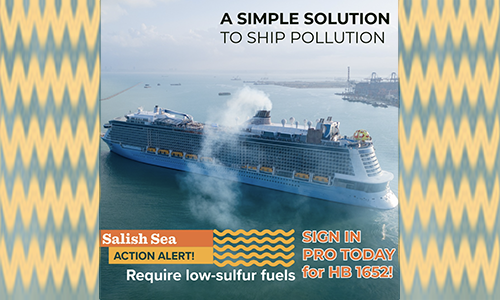— by Lovel Pratt , originally published in Whatcom Watch —
Lovel Pratt is a former member of the San Juan County Council. While in office she served on the Puget Sound Partnership Oil Spill Work Group, the Oil Spill Rule Advisory Committee and the Vessel Traffic Risk Assessment Update Steering Committee. She lives in Friday Harbor.
(Part One — Tanker Spill Scenarios” was published on Monday, Jan. 19)
Tanker Spill Scenarios
The worst possible oil spill would be from a crude oil tanker, given the volume and type of cargo. Tankers’ propulsion fuels are also a potential source of oil spills. Kinder Morgan’s Trans Mountain Pipeline Expansion (TMPE) project would increase the exports of Canadian tar sands crude oil through Georgia Strait, Boundary Pass, Haro Strait, and the Strait of Juan de Fuca from 300,000 barrels per day to 890,000 barrels per day (and potentially over a million barrels per day). 1 Tanker vessel traffic would increase from the current estimate of 60 tankers per year to up to 408 tankers, making 816 annual transits.2
This surge in traffic greatly increases the risk of a spill, according to the 2014 Vessel Traffic Rick Assessment.3 The Kinder Morgan projected increase would almost triple (by a factor of 2.76) the existing oil spill risk in Haro Strait and Boundary Pass and more than double (by a factor of 2.08) the risk in the western entrance to and (by a factor of 2.32) in the eastern area of the Strait of San Juan de Fuca, the study concluded.
Canadian tar sands crude oil (aka Alberta tar sands, oil sands and bitumen) is most typically transported in tankers, barges, pipelines and rail cars as diluted bitumen. Even diluted it is a heavy (defined in terms of weight or gravity, i.e., the oil’s density relative to water) and persistent crude oil (persistent oils break up and dissipate more slowly in the marine environment than do non-persistent oils).4 An oil spill of any product in Puget Sound/Salish Sea would have a high impact given the region’s tourism, residential, and fisheries economies. A spill of heavy and persistent Canadian tar sands crude oil in this region would be devastating both environmentally and economically.
If a tanker transporting Kinder Morgan’s Canadian tar sands crude oil has a spill, their liability is limited to a maximum of approximately $137 million (Canadian) with additional levels of international and Canadian oil pollution funds available up to approximately $1.3 billion (Canadian) for an individual spill.5
Kinder Morgan’s TMPE project application estimates that a Trans Mountain Pipeline related tanker’s credible worst-case spill volume is 104,000 barrels and the mean-case spill volume is 52,000 barrels.6 The $1.3 billion (Canadian) oil pollution funds available for an oil spill might appear to be sufficient to cover the costs and damages, but the heavy and persistent Canadian Tar Sands crude oil has higher cleanup costs than other crude oils.
A tragic precedent is the 2010 Enbridge pipeline Canadian tar sands crude oil spill that impacted approximately 38 miles of the Kalamazoo River and Talmadge Creek waterways.7 The spill volume is estimated at 843,000 gallons or 20,071 barrels. The cost to date of this spill, as reported by Enbridge on September 30, 2014, is $1.2 billion or nearly $60,000 per barrel.
At $60,000 per barrel, the cost of a Kinder Morgan TMPE related tanker’s mean-case spill would be $3.12 billion, and the cost of a credible worst-case spill would be $6.24 billion.8
Endnotes
- Kinder Morgan’s TMPE “theoretical future expansion scenario” that would bring the total to over a million barrels per day can be found in this ‘Engineering and safety’ response to Canada’s National Energy Board. See page 44 (listed as page 463 of 481) https://docs.neb-one.gc.ca/ll-eng/llisapi.dll/fetch /2000/90464/90552/548311/956726/2392873/2451003/2454322/B32-3_-_Trans_Mountain_Response_to_NEB_IR_No._1_2_of_2_-_A3W9H9.pdf?nodeid=2462074&vernum=1 accessed 12/14/2014.
- Kinder Morgan’s TMPE application. See https://application.transmountain.com/facilities-application accessed 12/12/2014. See also San Juan Islanders for Safe Shipping graphics and Kinder Morganユs Trans Mountain Oil Spill Study documents.
- Van Dorp, J. R., and J. Merrick. 2014. VTRA [Vessel Traffic Risk Assessment] 2010 Final Report: Preventing Oil Spills from Large Ships and Barges in Northern Puget Sound & Strait of Juan de Fuca. Prepared for Washington State Puget Sound Partnership. 166 p. See https://www.seas.gwu.edu/~dorpjr/VTRA/PSP/FINAL REPORT/PSP FINAL REPORT 033114 – SIGNED.pdf accessed 12/12/2014.
- See https://www.itopf.com/knowledge-resources/documents-guides/fate-of-oil-spills accessed 12/8/2014.
- See https://www.transmountain.com/marine-spill-liability accessed 11/22/2014.
- Kinder Morgan’s Trans Mountain Pipeline Expansion project application Volume 8A, Section 5.0 Risk Assessment and Spill Management. See https://transmountain.s3.amazonaws.com/application/V8A_3_of_4_5_TO_8_MAR_TRANS_ASSESS.pdf accessed 11/22/2014.
- See https://csr.enbridge.com/Systems-Integrity/Case-Studies/Marshall-Spill-Case-Study.aspx accessed 11/15/2014.
- The Kalamazoo River oil spill cleanup cost per barrel of $59,786.48 is based on the current EPA spill volume estimate of 843,000 gallons (see https://www.epa.gov/enbridgespill accessed 11/14/2014) and Enbridgeユs September 30, 2014 cost estimate included in its Third Quarter Report (see https://www.enbridge.com/~/media/www/Site%20Documents/Investor%20Relations/2014/2014_ENB_Q3_Report.pdf?la=en pages 7-9, Line 6B Crude Oil Release, accessed 11/14/2014).
**If you are reading theOrcasonian for free, thank your fellow islanders. If you would like to support theOrcasonian CLICK HERE to set your modestly-priced, voluntary subscription. Otherwise, no worries; we’re happy to share with you.**







